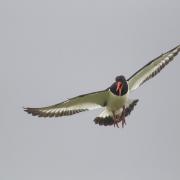The days are noticeably shorter but the weather can be glorious in September. Wildlife is in a state of flux at the moment. Most species have completed their breeding cycles and are either fattening up for a good, long sleep or migration to sunnie...
The days are noticeably shorter but the weather can be glorious in September. Wildlife is in a state of flux at the moment. Most species have completed their breeding cycles and are either fattening up for a good, long sleep or migration to sunnier climes.
Some species though are now approaching the part of their life cycle when they are most noticeable and this is particularly true for many types of fungi. Although we often think of autumn as the fungi season, they actually fruit all year round, each species having its own particular month.
However, the dying vegetation and increased human attention, particularly in woods, means we often go out far more in September and October to look for fungi. Last year was a good year for fungi in the Peak District, with abundant displays on fallen trees and the damp, woodland floor. Fungi forays are a great way to spend a day or two out in your local woods. Look out for Jew's ear on dead wood, it really does bear an uncanny resemblance to a human ear!
Russula and boletus are both large fungi families that grow on the woodland floor. The edible cep is a member of the boletus group. Virtually any wood will have fungi but you can increase your chances of seeing good numbers if you concentrate on deciduous woodland and look under large trees like beech. Usually people look for specimens at their best, and don't give a second glance to those that have started to decay, but last year I realised how fantastic the textures were. I certainly got some strange glances from a couple of walkers who watched me lying on the ground photographing a dead fungus! If you need a starting place then the woodland below Longshaw Lodge is a good area.
By now many moths have died or entered hibernation but a few species are still about and one I came across last year, the dusky thorn, is particularly attractive. The thorns are one of my favourite moth families because of the way they hold their wings, very much like a butterfly. As I sat and looked at this stunning moth the sun glanced through its wings creating a lovely backlit view, not the conventional way to show the moth but certainly the images are different.
As the month progresses many plants are really starting to pack up their summer operations and ready themselves for the coming cold and low light levels.We are all familiar with the autumnal colours as our trees make this annual change but another group of plants is doing a similar operation on a smaller scale - the ferns. Bracken, whilst a nuisance in many places, is stunning as it changes from the dark grey green of late summer into the gorgeous golds and yellows of autumn. Ferns, like mosses and liverworts, don't have flowers and don't make seeds but instead, at this time of year, make spores in small regularly placed cases under their leaves. The microscopic spores are released into the wind and settle far and wide. If the conditions are favourable a young fern will start its fragile life next spring.
The spores of bracken are thought to be dangerous to human health and this is one of the reasons why it's so disliked as a plant. As the trees lose their leaves and the small bird populations are at their highest, September is a good month to see sparrowhawks. The season's youngsters will be hunting vigorously trying to learn all the skills needed before the small bird populations decrease during winter. They also have to learn how to avoid cars and flying into large windows. Unfortunately many of the year's youngsters meet an untimely death in one of these ways. Small details are always worth paying attention to. Funnel web spiders sound like something straight out of the rainforest. There are though a number of funnel web spiders in the Peak, and whilst you may not see the spider itself (thankfully, I hear some of you say), their funnels are amazing wonders of the spider world. Look for them on the sides of trees like birch.
September is really the month of change as summer crosses into autumn. It's a brilliant month from a wildlife perspective because so much is happening and many summer species are still with us, yet some of the winter ones are arriving. If nothing else try to spend at least one day looking for fungi, or join a fungi foray. Many are advertised during September and October.


























